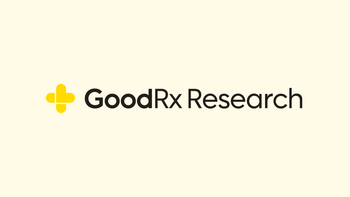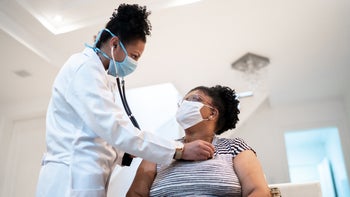
Survey: Many Americans Have Trouble Estimating the Cost of Their Healthcare
Key takeaways:
Only half of Americans can anticipate the out-of-pocket cost of seeing their primary care provider (PCP). Hospital prices are even trickier for people to estimate.
Half the population doesn’t know they can negotiate a medical bill — which can be a key factor in lowering healthcare costs.
Greater cost literacy is associated with higher confidence in managing one’s healthcare.

With healthcare costs and inflation on the rise, and disposable incomes tightening up, it’s more pressing than ever for Americans to be able to budget for their healthcare needs. But a new survey from GoodRx Research finds that healthcare costs remain unclear and confusing for consumers.
Patients need to understand the cost of a provider visit or procedure, so they can set aside money for out-of-pocket expenses. Unfortunately, the cost of a care visit has been baffling, surprising, and outright unknown to consumers for decades.
In 2021, the U.S. Department of Health and Human Services estimated that at least “1 out of 5 who go to the emergency room, have an elective surgery, or give birth in a hospital receive surprise bills.” Surprise medical bills affect one-third of insured adults and have contributed to 1 in 10 Americans owing medical debt or even declaring bankruptcy.
In light of this, the GoodRx Research team set out to understand how comfortable consumers are at predicting the cost of care. After surveying nearly 1,000 participants, we found that healthcare costs remain opaque, and Americans continue to pay the price.
Half of Americans still don't know how much a primary care provider visit will cost
Pre-pandemic, over 80% of U.S. adults saw a doctor at least once a year. This means that an annual physical exam is typically a recurring, planned, and expected expense. Despite that, only about 50% of respondents found it “very easy” or “easy” to predict the cost of a visit with their primary care provider (PCP).
For the 90% of Americans who have health insurance, determining the cost of a PCP visit comes down to factors like deductibles, copayments, and coinsurance. Very often, plan coverage is detailed in an online portal or in a consumer's summary of benefits. Still, nearly 50% of consumers find it hard to gauge these prices, indicating that current methods for conveying cost-of-care information are missing the mark.
But it turns out that consumers are actually most comfortable with understanding the cost of a PCP visit compared to other healthcare service costs. Below, we walk through how accurately consumers are able to foresee the cost of emergency room visits, hospital visits, and more.
Estimating the cost of a healthcare procedure is difficult
When it comes to healthcare procedures, even fewer people feel confident predicting the cost of care. In fact, 75% of people found it “difficult” or “very difficult” to know the cost of healthcare procedures such as labs, clinically administered medications, or surgeries in advance.
Being able to estimate healthcare procedure costs is crucial. The price of a common healthcare procedure like an appendectomy can range from $1,529 to a startling $182,955 — a dire indication of what one unestimated charge can do (and has done) to household finances.
Emergency room and urgent care costs are also unclear
The cost of an emergency room (ER) or urgent care visit, which can be notoriously expensive, is just as mysterious to patients. In fact, 71% found it “difficult” or “very difficult” to predict the cost of a trip to the ER.
Many of the 130 million people who visit the ER each year face high and variable bills for their admissions. Some of the more unknown, or unpredictable, ER costs include facility fees (fees that keep the ER running 24/7), high prescription drug prices (aspirin may cost up to $19 a tablet at a hospital), and out-of-network care.
To lower the rate of high, unpredictable hospital bills, the Centers for Medicare & Medicaid Services (CMS) established the Hospital Price Transparency rule in 2021. The rule requires hospitals to publish prices for their list of services — otherwise known as a chargemaster — and was intended to make price shopping and cost-planning easier for patients.
But even though hospitals have been required to make chargemasters publicly available since last year, only about a quarter of people reported knowing they exist.
Patients who are unaware of chargemasters may be more likely to be blindsided by hospital service charges (including bills from the ER, procedures, inpatient services, and more). That being said, chargemasters themselves can be extremely difficult to parse and interpret (our team found a number of challenges). Chargemasters do, however, highlight how inconsistent prices can be across hospitals.
Americans need to be able to price shop for their healthcare. And for them to do so, more accessible and transparent hospital pricing is needed.
Half of Americans don’t know they can negotiate medical bills
Even when patients are able to anticipate the cost of a healthcare expense, sometimes estimates can be off for reasons outside of their control. Specifically, it turns out that "over 80% of medical bills contain overcharges,'' according to Medliminal.
It's important to negotiate bills that include errors. Unfortunately, few are aware that contesting a medical bill is an option. In fact, 50% were not sure or didn’t know that they could contest or negotiate a bill.
Bills may contain overcharges because providers, clinics, and hospitals often use third-party medical-billing services (who only see what is documented on your medical record) to generate the bill. Common overcharges can include tests that weren’t actually performed, incorrect codes for procedures, and more.
So, the next time you receive a bill:
Ask for an itemized bill to ensure all the charges are correct.
Cross-check the items your insurer paid for with your explanation of benefits to make sure everything that should be covered was actually covered.
Talk with your provider and/or insurer if something seems off.
Why it all matters: Confidence
Budgeting isn’t the only important outcome at stake here; we also found that cost literacy correlates strongly with confidence in being able to manage one’s healthcare.
For example, those who find it “very easy” or “easy” to know the cost of a primary care visit are, on average, more confident in their ability to manage their healthcare than those who find it “difficult” or “very difficult.”
Similarly, those who knew it was possible to negotiate or contest a healthcare bill also felt more confident in managing their own healthcare.
Overall, improving consumers’ understanding of healthcare costs can both decrease out-of-pocket costs and build confidence in navigating the tricky U.S. healthcare system. Higher confidence creates a positive reinforcement cycle, too: It unlocks higher engagement in both health management and health finances, resulting in improved patient outcomes.
Summing it up
Budgeting for healthcare costs is important for every American family, and understanding expected medical costs is critical to that end. To get consumers the information they need, it’s important that insurers and billers improve cost transparency and that policies protect consumers from surprise charges.
Two new federal policies are intended to protect patients from surprise charges:
Since 2021, the Hospital Price Transparency rule has required hospitals to publish their list of services, or chargemaster.
Since the start of 2022, the No Surprises Act bans surprise bills, even if the service provided was out of network or without prior authorization.
Though chargemasters haven’t been very useful to patients, there is hope that the No Surprises Act may be more effective. Widespread sharing of educational materials can also help patients better understand their medical finances.
Here are some ways to keep your bills under control:
Review your insurance explanation of benefits to know what to expect when you seek medical care (And, while you’re at it: evaluate if your plan is actually the best one for your needs and budget).
Ask your providers (at the doctor’s office, clinics, and hospitals) for the cost of services — they’re required to give you a good-faith estimate.
Review and, if needed, contest your bills. If you’re denied for coverage by your insurer, or if a facility won’t fix an error on your bill, persistence is key.
Co-contributors: Sasha Guttentag, PhD, Tori Marsh, MPH
Methodology
Our survey was run through a YouGov panel. The survey ran from February 28, 2022, to March 7, 2022; a total of 926 responses were collected and analyzed. Survey responses were weighted to the U.S. population using age, gender, race, political affiliation and education level. More information on the YouGov survey methodology is available here.
References
Amadeo, K. (2022). Medical bankruptcy and the economy. The Balance.
Centers for Medicare & Medicaid Services. (2021). Hospital Price Transparency.
Centers for Medicare & Medicaid Services. (2022). No Surprises: Understand your rights against surprise medical bills
Centers for Medicare & Medicaid Services. (2022). Understanding costs in advance.
Hsia, R., et al. (2012). Health care as a ‘market good’? Appendicitis as a case study. JAMA Internal Medicine.
GoodRx Research. (2021). The Spread in Hospital Chargemaster Prices for Common Drugs.
IBISWorld. (2022). Per capita disposable income.
Konish, L. (2019). This is the real reason most Americans file for bankruptcy. CNBC.
Lopes, L., et al. (2020). Data note: Public worries about and experience with surprise medical bills. Kaiser Family Foundation.
National Center for Health Statistics. (2020). Emergency department visits.
National Center for Health Statistics. (2020). Percentage of having a doctor visit for any reason in the past 12 months for adults aged 18 and over, United States.
Kurani, N., et al. (2021). Price transparency and variation in U.S. health services. Peterson-KFF Health System Tracker.
Nunlist, M.M., et al. (2016). Using health confidence to improve patient outcomes. American Academy of Family Physicians.
Rae, M., et al. (2022). The burden of medical debt in the United States. Peterson-KFF Health System Tracker.
Rama, A. (2021). National health expenditures, 2019: Steady spending growth despite increases in personal health care expenditures in advance of the pandemic. American Medical Association.
U.S. Census Bureau. (2021). Health insurance coverage in the United States: 2020.
U.S. Department of Health & Human Services. (2022). HHS kicks off new year with new protections from surprise medical bills.
























